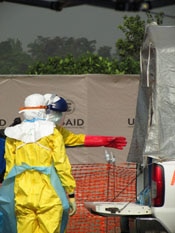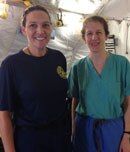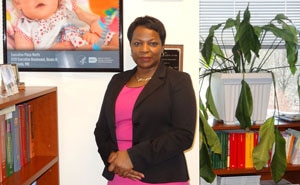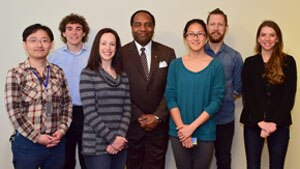News Around NIDDK
NIDDK staff help combat Ebola in West Africa
By Krysten Carrera

In the midst of the ongoing Ebola crisis in West Africa, during which more than 25,000 people to date have contracted the deadly virus, three intramural NIDDK staff answered the call to volunteer their services in some of the worst-affected areas. Nurse practitioners Michelle Braun and Michael Davis and registered nurse Megan Mattingly—all active members of the U.S. Public Health Service—each spent eight weeks in Liberia with their respective teams working to treat health care workers who became infected with Ebola.
The U.S. Public Health Service (PHS) is one of the seven uniformed services and is headed by the Surgeon General. PHS requires that its officers be ready to respond to urgent public health situations, frequently with short notice, and many of the officers serve in roles outside of PHS simultaneously. Braun has been part of PHS since 2001, and NIDDK since 2004. “Unwavering support from NIDDK leadership allowed us to fulfill our duties as Public Health Service members and serve the international community,” she said.
Braun and Davis, who work in NIDDK’s intramural Kidney Diseases Branch, were heavily relied upon by their respective teams for their nephrology expertise. These unique skill sets allowed their teams to address their patients’ kidney injury and failure, acid-base abnormalities, and fluid and electrolyte disturbances, all common complications of the Ebola virus.
“The kidneys filter wastes from the body and maintain fluid and electrolyte balance,” explained Braun. “Ebola causes large fluid losses and electrolyte imbalances and impairs kidneys’ ability to perform their normal functions. Those effects often limit a person’s ability to recover from Ebola. Michael and I treated people who desperately needed care after sustaining often severe kidney damage caused by this devastating disease.”

Davis, who arrived back in the United States in March, was the last of the three to return from Liberia. He helped adapt NIH's research protocol for the experimental drug ZMapp, which continues to undergo testing at the clinical level, to the study site in Liberia. He calls his deployment as difficult but rewarding.
“Not only we were fortunate to be able to help people in need and even save lives, but we also increased understanding of the virus through our work,” he said. “The days were long and trying, and I missed my family back home, but my challenges were nothing compared to the people suffering from Ebola.”
Mattingly agreed. “It was an honor to care for the Liberian patients, who had all contracted Ebola when caring for other sick people,” she said. “While my team was in Liberia we saw a consistent drop in the number of active Ebola patients there, which was very encouraging, but there’s still work to be done. We remain hopeful.”
“Michelle Braun, Michael Davis and Megan Mattingly are heroes who should be heralded as an example of how to make a real difference in the world,” said NIDDK Director Dr. Griffin P. Rodgers. “As with Hurricane Katrina in 2005, NIDDK’s response to the Ebola outbreak in coordination with the U.S. Public Health Service illustrates our continued commitment to improve people’s health and quality of life around the world.”
Getting to know: Dr. Marva Moxey-Mims

Dr. Marva Moxey-Mims is deputy director for clinical science in the NIDDK Division of Kidney, Urologic, and Hematologic Diseases, overseeing a portfolio of research including trials for kidney disease and genitourinary dysfunction in adults and children. In addition the pediatric nephrologist manages the division’s small business grants for kidney research. Moxey-Mims recently spoke with Amy F. Reiter about her career and accomplishments.
What drew you to medicine, and specifically to pediatric nephrology?
I was drawn to the promise of pediatrics. There’s nothing more rewarding than having a kid come in with something you can fix. The specialty was more serendipity—the pediatric nephrologists where I did my residency were just wonderful. They seemed to enjoy what they were doing so much, their enthusiasm was contagious, and I loved taking care of their patients. Also, the kidney is not the simplest organ, and I found that challenge to be appealing.
What drew you to NIH?
I was on staff at Children’s National Medical Center and I wanted better work-life balance—my husband is also a physician, and we had two young children at the time. I got a call from the FDA, which was looking for a nephrologist and had gotten my name. After a few years at the FDA, I learned the person overseeing the pediatric nephrology program at NIDDK was getting ready to retire. The job seemed tailor-made for me.
What achievements are you most proud of since you came here in 2002?
What I feel most proud of is growing the pediatric nephrology portfolio, encouraging pediatric nephrologists to apply for grants, and putting out initiatives to which they can apply. The two studies that I’m most proud of are the ongoing Chronic Kidney Disease in Children (CKiD) study—I’m proud of the information coming out of there and the number of trainees using that to do peds nephrology and epidemiology research—and the RIVUR trial, or Randomized Intervention for Children with Vesicoureteral Reflux, that was just completed with positive findings.
What is your hope for the next decade in your research area?
What I’m hoping is to see more clinical trials. I’m hoping more data will come out of the CKiD study—which is observational—that people will use as a framework to test actual interventions that will improve outcomes. We understand the disease process better, and key risk factors, but now we need to move forward. I’d also like to see more clinicians involved in clinical research in pediatric nephrology by being a study site or simply referring patients to a site. That happened with the RIVUR trial, and it helped make that trial a success.
How would you describe an average day at NIH?
Each day is quite different. You have meetings about policy issues, you have meetings about initiatives—where should we be putting NIH money? What kind of research should be encouraged? I also get a lot of calls from investigators and potential investigators. Some of their ideas are so innovative, you go wow. It’s also quite rewarding to work with the principal investigators, helping them find the right grant mechanism or helping them understand how to improve a grant application that didn’t make it through the first time.
What advice would you give people about entering research?
If you’re passionate about an idea, go with it and don’t be dissuaded if everyone doesn’t share your passion right away. Sell your idea—get people to see the great potential for going forward. The chances of someone getting a grant on the first try are low. Don’t feel like a failure, but take the critique and learn from it and try again. And ask us at NIDDK. We really do care about seeing good science go forward. Don’t be afraid to call us.
NIDDK Fellow Scientific Conference

NIDDK Director Dr. Griffin P. Rodgers stands with award winners of the NIDDK Fellow Scientific Conference, a two-day research and career development event designed to bring together fellows and scientists from NIDDK's Intramural Research Program. Goals of the meeting include encouraging cross-fertilization of ideas, fostering new collaborations, and promoting a sense of community among NIDDK researchers. Awardees were recognized for their outstanding and innovative research and their excellent presentation skills.
